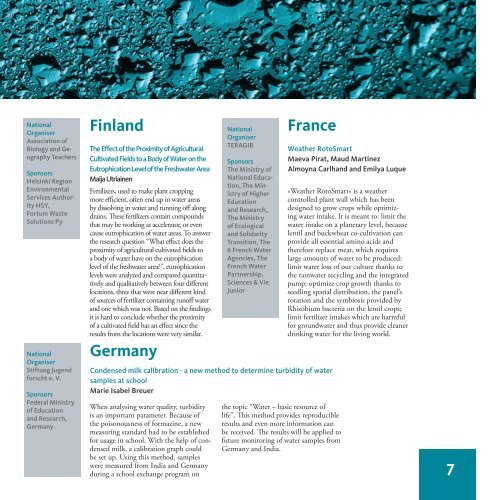2017 Stockholm Junior Water Prize Finalists
Each year, the Stockholm Junior Water Prize congregates young scientists and innovators from around the world who have created new solutions to the planet’s growing water challenges. Each of the finalists represented in Stockholm are the champions of their national competition and have been selected as winners from thousands of entries for their outstanding work.
Each year, the Stockholm Junior Water Prize congregates young scientists and innovators from around the world who have created new
solutions to the planet’s growing water challenges. Each of the finalists represented in Stockholm are the champions of their national
competition and have been selected as winners from thousands of entries for their outstanding work.
You also want an ePaper? Increase the reach of your titles
YUMPU automatically turns print PDFs into web optimized ePapers that Google loves.
National<br />
Organiser<br />
Association of<br />
Biology and Geography<br />
Teachers<br />
Sponsors<br />
Helsinki Region<br />
Environmental<br />
Services Authority<br />
HSY,<br />
Fortum Waste<br />
Solutions Py<br />
National<br />
Organiser<br />
Stiftung Jugend<br />
forscht e. V.<br />
Sponsors<br />
Federal Ministry<br />
of Education<br />
and Research,<br />
Germany<br />
Finland<br />
The Effect of the Proximity of Agricultural<br />
Cultivated Fields to a Body of <strong>Water</strong> on the<br />
Eutrophication Level of the Freshwater Area<br />
Maija Utriainen<br />
Fertilizers, used to make plant cropping<br />
more efficient, often end up in water areas<br />
by dissolving in water and running off along<br />
drains. These fertilizers contain compounds<br />
that may be working as accelerator, or even<br />
cause eutrophication of water areas. To answer<br />
the research question “What effect does the<br />
proximity of agricultural cultivated fields to<br />
a body of water have on the eutrophication<br />
level of the freshwater area?”, eutrophication<br />
levels were analyzed and compared quantitatively<br />
and qualitatively between four different<br />
locations, three that were near different kind<br />
of sources of fertilizer containing runoff water<br />
and one which was not. Based on the findings<br />
it is hard to conclude whether the proximity<br />
of a cultivated field has an effect since the<br />
results from the locations were very similar.<br />
Germany<br />
Condensed milk calibration - a new method to determine turbidity of water<br />
samples at school<br />
Marie Isabel Breuer<br />
When analysing water quality, turbidity<br />
is an important parameter. Because of<br />
the poisonousness of formazine, a new<br />
measuring standard had to be established<br />
for usage in school. With the help of condensed<br />
milk, a calibration graph could<br />
be set up. Using this method, samples<br />
were measured from India and Germany<br />
during a school exchange program on<br />
National<br />
Organiser<br />
TERAGIR<br />
Sponsors<br />
The Ministry of<br />
National Education,<br />
The Ministry<br />
of Higher<br />
Education<br />
and Research,<br />
The Ministry<br />
of Ecological<br />
and Solidarity<br />
Transition, The<br />
6 French <strong>Water</strong><br />
Agencies, The<br />
French <strong>Water</strong><br />
Partnership,<br />
Sciences & Vie<br />
<strong>Junior</strong><br />
France<br />
the topic “<strong>Water</strong> – basic resource of<br />
life”. This method provides reproducible<br />
results and even more information can<br />
be received. The results will be applied to<br />
future monitoring of water samples from<br />
Germany and India.<br />
Weather RotoSmart<br />
Maeva Pirat, Maud Martinez<br />
Almoyna Carlhand and Emilya Luque<br />
«Weather RotoSmart» is a weather<br />
controlled plant wall which has been<br />
designed to grow crops while optimizing<br />
water intake. It is meant to: limit the<br />
water intake on a planetary level, because<br />
lentil and buckwheat co-cultivation can<br />
provide all essential amino acids and<br />
therefore replace meat, which requires<br />
large amounts of water to be produced;<br />
limit water loss of our culture thanks to<br />
the rainwater recycling and the integrated<br />
pump; optimize crop growth thanks to<br />
seedling spatial distribution, the panel’s<br />
rotation and the symbiosis provided by<br />
Rhizobium bacteria on the lentil crops;<br />
limit fertilizer intakes which are harmful<br />
for groundwater and thus provide cleaner<br />
drinking water for the living world.<br />
7


















